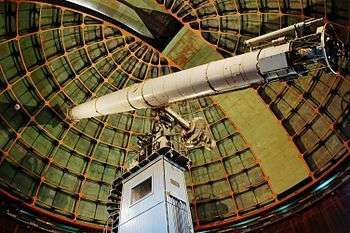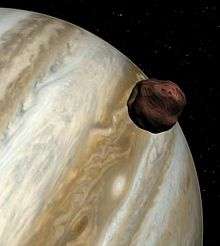Lick Observatory
 Lick Observatory's Great Lick 91-centimeter (36-inch) telescope housed in the South (large) Dome of main building | |||||||||||||||
| Code | 662 | ||||||||||||||
|---|---|---|---|---|---|---|---|---|---|---|---|---|---|---|---|
| Location | San Jose, California, USA | ||||||||||||||
| Coordinates | 37°20′29″N 121°38′34″W / 37.34139°N 121.64278°WCoordinates: 37°20′29″N 121°38′34″W / 37.34139°N 121.64278°W | ||||||||||||||
| Altitude | 1,283 m (4,209 ft) | ||||||||||||||
| Weather | 300 clear nights/year | ||||||||||||||
| Website | http://www.ucolick.org | ||||||||||||||
| Telescopes | |||||||||||||||
| |||||||||||||||
|
| |||||||||||||||
The Lick Observatory is an astronomical observatory, owned and operated by the University of California. It is situated on the summit of Mount Hamilton, in the Diablo Range just east of San Jose, California, USA. The observatory is managed by the University of California Observatories, with headquarters on the University of California, Santa Cruz, campus, where its scientific staff moved in the mid-1960s.
Early history
Lick Observatory is the world's first permanently occupied mountain-top observatory.[1] The observatory, in a Classical Revival style structure, was constructed between 1876 and 1887, from a bequest from James Lick of $700,000 (approximately $22 million in 2014 US dollars).[2] Lick, although primarily a carpenter and piano maker, chose the precise site atop Mount Hamilton and was buried there in 1887 under the future site of the telescope,[2] with a brass tablet bearing the inscription, "Here lies the body of James Lick".

Lick additionally requested that Santa Clara County construct a "first-class road" to the summit, completed in 1876.[2] Lick chose John Wright, of San Francisco's Wright & Sanders firm of architects, to design both the Observatory and the Astronomer's House.</California Architect and Business News, 9/1881; Lick Observatory Archives. ref>All of the construction materials had to be brought to the site by horse and mule-drawn wagons, which could not negotiate a steep grade. To keep the grade below 6.5%, the road had to take a very winding and sinuous path, which the modern-day road (California State Route 130) still follows. Tradition maintains that this road has exactly 365 turns (This is approximately correct, although uncertainty as to what should count as a turn makes precise verification impossible). The road is closed when there is snow at Lick Observatory.[3]
The first telescope installed at the observatory was a 12-inch refractor made by Alvan Clark. Astronomer E. E. Barnard used the telescope to make "exquisite photographs of comets and nebulae," according to D. J. Warner of Warner & Swasey Company.[2]

The 91-centimeter (36-inch) refracting telescope on Mt. Hamilton was Earth's largest refracting telescope during the period from when it saw first light on January 3, 1888, until the construction of Yerkes Observatory in 1897. Warner & Swasey designed and built the telescope mounting, with the 91-centimeter (36-inch) lens manufactured by one of the Clark sons, Alvan Graham. E. E. Barnard used the telescope in 1892 to discover a fifth moon of Jupiter, Amalthea. This was the first addition to Jupiter's known moons since Galileo observed the planet through his parchment tube and spectacle lens. The telescope provided spectra for W. W. Campbell's work on the radial velocities of stars.[2]
In May 1888, the observatory was turned over to the Regents of the University of California,[4] and it became the first permanently occupied mountain-top observatory in the world. Edward Singleton Holden was the first director. The location provided excellent viewing performance because of lack of ambient light and pollution; additionally, the night air at the top of Mt. Hamilton is extremely calm, and the mountain peak is normally above the level of the low cloud cover that is often seen in the San Jose area. When low cloud cover is present below the peak, light pollution is cut to almost nothing.
On May 21, 1939, during a nighttime fog that engulfed the summit, a U.S. Army Air Force Northrop A-17 two-seater attack plane crashed into the main building. Because a scientific meeting was being held elsewhere, the only staff member present was Nicholas Mayall. Nothing caught fire and the two individuals in the building were unharmed. The pilot of the plane, Lt. Richard F. Lorenz, and passenger Private W. E. Scott were killed instantly. The telephone line was broken by the crash, so no help could be called for at first. Eventually help arrived together with numerous reporters and photographers, who kept arriving almost all night long. Evidence of their numbers could be seen the next day by the litter of flash bulbs carpeting the parking lot. The press widely covered the accident and many reports emphasized the luck in not losing a large cabinet of spectrograms which was knocked over by the crash coming through an astronomer's office window. Perhaps more notable was the lack of fire or damage to a telescope dome.[5][6][7][8]
In 1950, the California state legislature appropriated funds for a 300-centimeter (120-inch) reflector telescope, which was completed in 1959. The observatory additionally has a 61-centimeter (24-inch) Cassegrain reflector dedicated to photoelectric measurements of star brightness, and received a pair of 51-centimeter (20-inch) astrographs from the Carnegie Corporation.[2]
Current state

With the growth of San Jose, and the rest of Silicon Valley, light pollution became a problem for the observatory. In the 1970s, a site in the Santa Lucia Mountains at Junípero Serra Peak, southeast of Monterey, was evaluated for possible relocation of many of the telescopes. However, funding for the move was not available, and in 1980 San Jose began a program to reduce the effects of lighting, most notably replacing all streetlamps with low pressure sodium lamps. The result is that the Mount Hamilton site remains a viable location for a major working observatory. The International Astronomical Union named Asteroid 6216 San Jose to honor the city's efforts toward reducing Light pollution.[9]
In 2006, there were 23 families in residence, plus typically between two and ten visiting astronomers from the University of California campuses, who stay in dormitories while working at the observatory. The little town of Mount Hamilton atop the mountain has its own police and a post office, and until recently a one-room schoolhouse.[10]
In 2008, there were 38 people residing on the mountain; the chef and commons dinner were decommissioned. By 2013, with continuing budget and staff cuts there remain only about nineteen residents and it is common for the observers to work from remote observing stations rather than make the drive, partly as a result of the business office raising the cost to stay in the dorms, the swimming pool has been removed.
In 2013, one of Lick Observatory's key funding sources was scheduled for elimination in 2018, which many worried would result in the closing of the entire observatory.[11] [12]
In November 2014, the University of California announced its intention to continue support of Lick Observatory.[13]
Significant discoveries
The following astronomical objects were discovered at Lick Observatory:
- Several moons of Jupiter[14]
- Near-Earth asteroid (29075) 1950 DA
- Several extrasolar planets
- Quintuple planet system
- Triple planet system
- Double planet systems
- HD 38529 (with Keck Observatory)
- HD 12661 (with Keck)
- Gliese 876 (with Keck)
- 47 Ursae Majoris
Equipment

Current equipment and locations:
- the C. Donald Shane telescope 3-meter (120-inch) reflector (Shane Dome, Tycho Brahe Peak)
- the Hamilton spectrometer.
- the Automated Planet Finder 2.4-meter (94-inch) reflector. First light was originally scheduled for 2006. The telescope finally came into regular use in 2013.
- the Anna L. Nickel 1-meter (39-inch) reflector (North (small) Dome, Main Building)
- the Great Lick 91-centimeter (36-inch) refractor (South Dome, Main Building, Observatory Peak)
- the Crossley 90-centimeter (35-inch) reflector (Crossley Dome, Ptolemy Peak)
- the Katzman Automatic Imaging Telescope (KAIT) 76-centimeter (30-inch) reflector (24-inch Dome, Kepler Peak)
- the 60-centimeter (24-inch) Coudé Auxiliary Telescope (Inside of Shane Dome, South wall, Tycho Brahe Peak)
- the Tauchmann 50-centimeter (20-inch) reflector (Tauchmann Dome atop the water tank, Huygens Peak)
- the Carnegie 50-centimeter (20-inch) twin refractor (Double Astrograph Dome, Tycho Brahe Peak)
Removed equipment:
- CCD Comet Camera 135 mm Nikon camera lens ("The Outhouse" Southwest of the Shane Dome, Tycho Brahe Peak)
See also
- Charles Dillon Perrine
- List of largest optical refracting telescopes
- William Wallace Campbell, director of Lick Observatory, 1900–1930
Footnotes
- ↑ The Building of Lick Observatory
- 1 2 3 4 5 6 Kirby-Smith, H. T. (1976). U.S. Observatories. New York, USA: Litton Educational Publishing, Inc. ISBN 0-442-24451-7.
- ↑ Mount Hamilton (California)
- ↑ "The Lick Observatory Completed (from San Francisco Alto May 22, 1888)". The New York Times. May 29, 1888. p. 5. ISSN 0362-4331.
Sometime this week the Trustees of the James Lick Estate will convey to the Board of Regents of the State University the Mount Hamilton Observatory.
- ↑ Mayall, Nicholas Ulrich (1970). "Nicholas U. Mayall". In Stone, Irving. There was light: Autobiography of a university: Berkeley, 1868-1968. Garden City, New York: Doubleday & Company, Inc. pp. 117–8.
- ↑ "2 Die as Army Plane Hits Lick Observatory, Damaging Offices and Destroying Records". The New York Times (Late City ed.). Associated Press. May 22, 1939. p. 1. ISSN 0362-4331.
Lost in thick fog, an army attack plane crashed into Lick Astronomical Observatory of the University of California on Mount Hamilton tonight. Its two occupants were killed. They were Lieut. R. F. Lorenz, 25, of March Field, the pilot, and Private W. E. Scott, a passenger.
- ↑ Airplane Crash at the Lick Observatory
- ↑ The Lick Observatory A-17A
- ↑ UCSC, Lick Observatory designate asteroid for the city of San Jose
- ↑ "Mt. Hamilton Elementary - School Directory Details (CA Dept of Education)". CA Dept of Education. Retrieved October 15, 2015.
- ↑ Hoban, Virgie (September 2, 2014). "Facing a Waning Future". The Daily Californian. Berkeley, California. pp. 1+. Retrieved September 4, 2014.
- ↑ Overbye, Dennis (June 3, 2014). "A Star-Gazing Palace's Hazy Future". New York Times. Retrieved September 4, 2014. (registration required (help)).
- ↑ Lebow, Hilary (Nov 4, 2014). "UC Confirms Continued Support of Lick Observatory". UC Santa Cruz. pp. 1+. Retrieved Nov 4, 2014.
- ↑ Proctor, Mary (March 5, 1905). "Jupiter's Newly Discovered Moons and Solar Cyclones". The New York Times. New York City. Retrieved October 1, 2014.
- ↑ Bernard, E. E. (October 4, 1892). "Discovery and Observations of a Fifth Satellite to Jupiter". Astronomical Journal. Bibcode:1892AJ.....12...81B. doi:10.1086/101715.
- ↑ Perrine, C. D. (March 30, 1905). "The Seventh Satellite of Jupiter". Publications of the Astronomical Society of the Pacific. 17 (101): 62–63. Bibcode:1905PASP...17...56.. doi:10.1086/121624. JSTOR 40691209.
- ↑ Nicholson, S. B. (1914). "Discovery of the Ninth Satellite of Jupiter". Publications of the Astronomical Society of the Pacific. 26: 197–198. Bibcode:1914PASP...26..197N. doi:10.1086/122336.
- ↑ Fischer, Debra A.; Marcy, Geoffrey W. (March 1, 2008). "Five Planets Orbiting 55 Cancri". The Astrophysical Journal. The American Astronomical Society. 675 (1): 790–801. arXiv:0712.3917
 . Bibcode:2008ApJ...675..790F. doi:10.1086/525512. Retrieved October 1, 2014.
. Bibcode:2008ApJ...675..790F. doi:10.1086/525512. Retrieved October 1, 2014.
References
- Campbell, William Wallace (September 1902). "The Lick Observatory And Its Problems". Overland Monthly, and Out West Magazine. XL (3): 321–. Retrieved 2009-08-15.
- Vasilevskis, S. and Osterbrock, D. E. (1989) "Charles Donald Shane" Biographical Memoirs, Volume 58 pp. 489–512, National Academy of Sciences, Washington, DC, ISBN 0-309-03938-X
Further reading
- Holden, Edward S. (1888). Hand-book of the Lick Observatory of the University of California.
- "Lick Observatory Edition". Mining and Scientific Press. June 23, 1888.
External links
| Wikimedia Commons has media related to: |
| Wikisource has the text of the 1920 Encyclopedia Americana article Lick Observatory. |
- Lick Observatory
- Lick Observatory Records Digital Archive, from the UC Santa Cruz Library's Digital Collections
- The University of California Observatories

